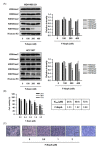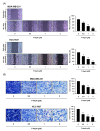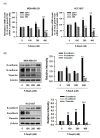Antiproliferative and Antimigration Activities of Fluoro-Neplanocin A via Inhibition of Histone H3 Methylation in Triple-Negative Breast Cancer
- PMID: 32244385
- PMCID: PMC7226301
- DOI: 10.3390/biom10040530
Antiproliferative and Antimigration Activities of Fluoro-Neplanocin A via Inhibition of Histone H3 Methylation in Triple-Negative Breast Cancer
Abstract
Triple-negative breast cancer (TNBC) is among the most aggressive and potentially metastatic malignancies. Most affected patients have poor clinical outcomes due to the lack of specific molecular targets on tumor cells. The upregulated expression of disruptor of telomeric silencing 1-like (DOT1L), a histone methyltransferase specific for the histone H3 lysine 79 residue (H3K79), is strongly correlated with TNBC cell aggressiveness. Therefore, DOT1L is considered a potential molecular target in TNBC. Fluoro-neplanocin A (F-NepA), an inhibitor of S-adenosylhomocysteine hydrolase, exhibited potent antiproliferative activity against various types of cancer cells, including breast cancers. However, the molecular mechanism underlying the anticancer activity of F-NepA in TNBC cells remains to be elucidated. We determined that F-NepA exhibited a higher growth-inhibitory activity against TNBC cells relative to non-TNBC breast cancer and normal breast epithelial cells. Moreover, F-NepA effectively downregulated the level of H3K79me2 in MDA-MB-231 TNBC cells by inhibiting DOT1L activity. F-NepA also significantly inhibited TNBC cell migration and invasion. These activities of F-NepA might be associated with the upregulation of E-cadherin and downregulation of N-cadherin and Vimentin in TNBC cells. Taken together, these data highlight F-NepA as a strong potential candidate for the targeted treatment of high-DOT1L-expressing TNBC.
Keywords: DOT1L; H3K79me2; fluoro-neplanocin A; histone H3 lysine methylation; metastasis; triple-negative breast cancer.
Conflict of interest statement
The authors declare no conflict of interest.
Figures






Similar articles
-
Inhibition of DOT1L by Half-Selenopsammaplin A Analogs Suppresses Tumor Growth and EMT-Mediated Metastasis in Triple-Negative Breast Cancer.Pharmaceuticals (Basel). 2020 Dec 28;14(1):18. doi: 10.3390/ph14010018. Pharmaceuticals (Basel). 2020. PMID: 33379275 Free PMC article.
-
Targeting Histone Methyltransferase DOT1L by a Novel Psammaplin A Analog Inhibits Growth and Metastasis of Triple-Negative Breast Cancer.Mol Ther Oncolytics. 2019 Oct 1;15:140-152. doi: 10.1016/j.omto.2019.09.005. eCollection 2019 Dec 20. Mol Ther Oncolytics. 2019. PMID: 31720371 Free PMC article.
-
Silencing or inhibition of H3K79 methyltransferase DOT1L induces cell cycle arrest by epigenetically modulating c-Myc expression in colorectal cancer.Clin Epigenetics. 2019 Dec 30;11(1):199. doi: 10.1186/s13148-019-0778-y. Clin Epigenetics. 2019. PMID: 31888761 Free PMC article.
-
DNMT1: A key drug target in triple-negative breast cancer.Semin Cancer Biol. 2021 Jul;72:198-213. doi: 10.1016/j.semcancer.2020.05.010. Epub 2020 May 24. Semin Cancer Biol. 2021. PMID: 32461152 Review.
-
Tackling triple negative breast cancer with HDAC inhibitors: 6 is the isoform!Eur J Med Chem. 2024 Dec 5;279:116884. doi: 10.1016/j.ejmech.2024.116884. Epub 2024 Sep 16. Eur J Med Chem. 2024. PMID: 39321690 Review.
Cited by
-
Anticancer Activity of Enantiomeric Neplanocins A: Exploring the Role of Chirality in Tumor Suppression.Int J Mol Sci. 2025 Feb 4;26(3):1308. doi: 10.3390/ijms26031308. Int J Mol Sci. 2025. PMID: 39941076 Free PMC article.
-
The Chromatin Response to Double-Strand DNA Breaks and Their Repair.Cells. 2020 Aug 7;9(8):1853. doi: 10.3390/cells9081853. Cells. 2020. PMID: 32784607 Free PMC article. Review.
-
Inhibition of DOT1L by Half-Selenopsammaplin A Analogs Suppresses Tumor Growth and EMT-Mediated Metastasis in Triple-Negative Breast Cancer.Pharmaceuticals (Basel). 2020 Dec 28;14(1):18. doi: 10.3390/ph14010018. Pharmaceuticals (Basel). 2020. PMID: 33379275 Free PMC article.
-
Antitumor Activity of Pulvomycin via Targeting Activated-STAT3 Signaling in Docetaxel-Resistant Triple-Negative Breast Cancer Cells.Biomedicines. 2021 Apr 17;9(4):436. doi: 10.3390/biomedicines9040436. Biomedicines. 2021. PMID: 33920736 Free PMC article.
-
DOT1L promotes expression of CD44 through the Wnt/β-catenin signaling pathway in early gastric carcinoma.J Cancer. 2024 Feb 25;15(8):2276-2291. doi: 10.7150/jca.90170. eCollection 2024. J Cancer. 2024. PMID: 38495505 Free PMC article.
References
-
- Byun W.S., Kim W.K., Han H.J., Chung H.-J., Jang K., Kim H.S., Kim S., Kim D., Bae E.S., Park S., et al. Targeting histone methyltransferase DOT1L by a novel psammaplin A analog inhibits growth and metastasis of triple-negative breast cancer. Mol. Ther. Oncolytics. 2019;15:140–152. doi: 10.1016/j.omto.2019.09.005. - DOI - PMC - PubMed
-
- Colleoni M., Sun Z., Price K.N., Karlsson P., Forbes J.F., Thürlimann B., Gianni L., Castiglione M., Gelber R.D., Coates A.S., et al. Annual hazard rates of recurrence for breast cancer during 24 years of follow-up: Results from the international breast cancer study group trials I to V. J. Clin. Oncol. 2016;34:927–935. doi: 10.1200/JCO.2015.62.3504. - DOI - PMC - PubMed
Publication types
MeSH terms
Substances
Grants and funding
LinkOut - more resources
Full Text Sources
Research Materials
Miscellaneous

